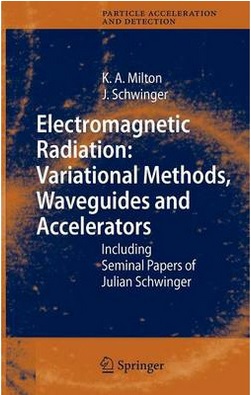
Electromagnetic Radiation, Variational Methods, Waveguides and Accelerators: Including Seminal Papers of Julian Schwinger
[BOOK DESCRIPTION]
Julian Schwinger was already the world's leading nuclear theorist when he joined the Radiation Laboratory at MIT in 1943, at the ripe age of 25. Just 2 years earlier he had joined the faculty at Purdue, after a postdoc with OppenheimerinBerkeley,andgraduatestudyatColumbia. Anearlysemester at Wisconsin had con?rmed his penchant to work at night, so as not to have to interact with Breit and Wigner there. He was to perfect his iconoclastic 1 habits in his more than 2 years at the Rad Lab. Despite its deliberately misleading name, the Rad Lab was not involved in nuclear physics, which was imagined then by the educated public as a esoteric science without possible military application. Rather, the subject at hand was the perfection of radar, the beaming and re?ection of microwaves which had already saved Britain from the German onslaught. Here was a technology which won the war, rather than one that prematurely ended it, at a still incalculable cost. It was partly for that reason that Schwinger joined this e?ort, rather than what might have appeared to be the more natural project for his awesome talents, the development of nuclear weapons at Los Alamos. He had got a bit of a taste of that at the "Metallurgical Laboratory" in Chicago, and did not much like it. Perhaps more important for his decision to go to and stay at MIT during the war was its less regimented and isolated environment.
[TABLE OF CONTENTS]
- A Treatise on Radiation Theory.
- Maxwell's Equations.
- Spherical Harmonics.
- Relativistic Transformations.
- Variational Principles for Harmonic Time Dependence.
- Transmission Lines.
- Waveguides and Equivalent Transmission Lines.
- Rectangular and Triangular Waveguides.
- Electromagnetic Fields in Waveguides with Circular Cross Sections.
- Reflection and Refraction.
- Variational Methods.
- Examples of Variational Calculations for Circular Guide.
- Steady Currents and Dissipation.
- The Impedance Concept in Waveguides.
- Accelerators: Microtrons and Synchrotrons.
- Synchrotron Radiation.
- Diffraction.
- Quantum Limitations on Microwave Oscillators.
- Relevant Papers of Julian Schwinger.
- On the Representation of the Electric and Magnetic Fields Produced by Currents and Discontinuities in Wave Guides. I.
- Electron Orbits in the Synchrotron.
- On Radiation by Electrons in a Betatron.
- On the Classical Radiation of Accelerated Electrons.
- The Quantum Correction in the Radiation by Energetic Accelerated Electrons.
- Classical Radiation of Accelerated Electrons. II. A Quantum Viewpoint.
- Classical and Quantum Theory of Synergic Synchrotron-?erenkov Radiation.
- New Approach to Quantum Corrections in Synchrotron Radiation.
- On the Radiation of Sound from an Unflanged Circular Pipe.
- On the Theory of Diffraction by an Aperture in an Infinite Plane Screen. I.
- On the Theory of Diffraction by an Aperture in an Infinite Plane Screen. II..
- On the Transmission Coefficient of a Circular Aperture.
- On the Theory of Electromagnetic Wave Diffraction by an Aperture in an Infinite Plane Conducting Screen.

 新书报道
新书报道